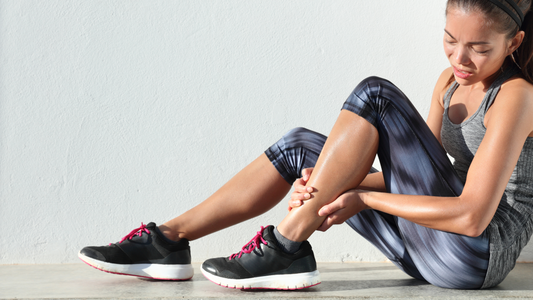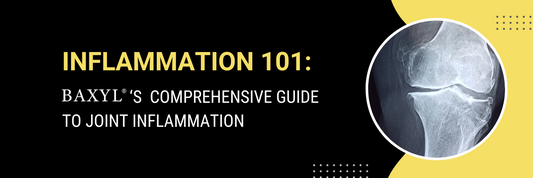
Springtime means a flurry of outdoor activities. Baseball and softball are the great American pastime. Soccer fields are filling up across various parts of the country. Athletes are competing in outdoor track as the weather starts to cooperate. More people are taking advantage of the weather and becoming active. With those increased activities, the chances also increase for inflammation in the leg muscles.
Inflammation in the leg muscles, also known as myositis, can occur due to various factors. Let’s explore some of those causes and how inflammation can impact athletic performance.

Inflammation Caused by Injuries
Injury or Trauma
Strains, sprains, contusions or other forms of physical trauma to the leg muscles can lead to inflammation. This inflammation is part of the body's natural healing response to tissue damage.
Overuse or Repetitive Stress
Excessive or repetitive use of the leg muscles, such as during intense physical activity, exercise or repetitive movements, can cause microtrauma and inflammation in the muscle fibers.
Infections
Bacterial, viral, fungal, or parasitic infections can cause inflammation in the leg muscles, leading to conditions such as bacterial myositis or viral myositis.

Other Causes of Inflammation to the Leg Muscles
Autoimmune Disorders
Autoimmune disorders, such as polymyositis or dermatomyositis, occur when the immune system mistakenly attacks healthy muscle tissue, resulting in inflammation and muscle weakness.
Metabolic Disorders
Metabolic disorders, such as metabolic myopathies or inflammatory myopathies, can cause inflammation in the leg muscles due to abnormalities in metabolic processes or immune system dysfunction.
Inflammatory Conditions
Inflammatory conditions, such as rheumatoid arthritis or lupus, can cause systemic inflammation that affects multiple tissues and organs, including the muscles in the legs.
Toxicity
Exposure to certain toxins, chemicals or medications can cause inflammation in the leg muscles as a side effect or toxic reaction.
Ischemia
Insufficient blood flow to the leg muscles, often due to vascular diseases or conditions such as peripheral artery disease (PAD), can lead to tissue ischemia and inflammation.
Allergic Reactions
Allergic reactions to medications, foods, insect bites or environmental allergens can trigger inflammation in the leg muscles as part of an allergic response.
Systemic Inflammatory Response Syndrome (SIRS)
Severe systemic inflammation triggered by infections, trauma, surgery or other systemic insults can lead to widespread inflammation, including in the leg muscles.
The specific cause of inflammation in the leg muscles can vary depending on individual circumstances, underlying health conditions and environmental factors. Proper diagnosis and treatment by a healthcare professional are essential for identifying the underlying cause and addressing inflammation effectively.

Inflammation Impacts Athletic Performance
Anytime you experience Inflammation in the leg muscles, it is likely going to impact your athletic performance. Inflammation can impact athletic performance in several ways, both positively and negatively, depending on the context and severity of inflammation. Here are some ways in which inflammation can affect athletic performance:
Acute Inflammation Response
In response to exercise or physical activity, the body may experience acute inflammation, which is a natural and temporary response to tissue damage and stress. This type of inflammation helps initiate the healing process and adapts the body to physical training. In the short term, acute inflammation can enhance athletic performance by promoting tissue repair, muscle growth and adaptation to training stimuli.
Delayed Onset Muscle Soreness (DOMS)
DOMS is a type of inflammation that occurs 24-48 hours after intense or unfamiliar exercise, resulting in muscle pain, stiffness and tenderness. While DOMS is a normal part of the muscle repair process, severe or prolonged DOMS can impair athletic performance by limiting range of motion, muscle function and exercise capacity.
Chronic Inflammation
Chronic inflammation, on the other hand, can have detrimental effects on athletic performance. Chronic inflammation may result from repetitive stress, overtraining, poor recovery, inadequate nutrition or underlying health conditions. Chronic inflammation can impair muscle recovery, increase injury risk and lead to fatigue, decreased exercise tolerance and reduced athletic performance over time.
Muscle Damage & Injury Risk
Inflammatory responses to exercise-induced muscle damage can increase the risk of injuries such as strains, sprains and overuse injuries. Excessive inflammation and inadequate recovery can prolong healing time and impair performance, as injured muscles may not function optimally during exercise.
Immune Function
Intense or prolonged exercise can temporarily suppress the immune system, leading to increased susceptibility to infections and illness. Inflammation plays a role in immune function, and excessive or chronic inflammation may further compromise immune health and athletic performance.
Oxidative Stress
Exercise-induced inflammation can contribute to oxidative stress, which occurs when the body's antioxidant defenses are overwhelmed by reactive oxygen species (ROS). Oxidative stress can damage cells and tissues, impair muscle function and hinder recovery, negatively impacting athletic performance.
Nutrient Utilization
Inflammation can impact nutrient utilization and metabolism, potentially altering energy production, protein synthesis and nutrient absorption. Proper nutrition and hydration are essential for managing inflammation and supporting athletic performance.
Recovery & Adaptation
Balancing inflammation and recovery are crucial for optimizing athletic performance and adaptation to training. Adequate rest, recovery strategies and periodization of training are important for managing inflammation, promoting tissue repair and maximizing performance gains over time.
Overall, inflammation is a complex physiological response that can have both beneficial and detrimental effects on athletic performance. By understanding inflammation’s role in exercise physiology and implementing appropriate training, recovery and nutrition strategies, athletes can manage inflammation effectively to enhance performance, reduce injury risk and support well-being.

MHB3® Hyaluronan
If you are looking for a natural way to relieve your inflammatory response and soothe your achy joints, you should learn more about Baxyl® Sport because it contains the gold standard of hyaluronic acids, MHB3® Hyaluronan.
MHB3® Hyaluronan has eight U.S. patents and is proven, all-natural. MHB3 delivers hyaluronic acid (HA) to the synovial fluid in between the joints while also kick-starting the body’s own natural HA production process. It is unique to other hyaluronic acid supplements on the market due to its oral liquid formulation that allows for quick absorption and maximum efficacy.
The liquid nature of MHB3 has been proven to be absorbed 3.8x better by the human body than dry or other hyaluronic acid forms. MHB3 holds U.S. Patents for the prevention and maintenance of osteoarthritis, osteopenia (precursor to osteoporosis), osteophytes (bone spurs) and the amelioration of joint health.
The Baxyl® Solution
All Baxyl products are formulated with MHB3 Hyaluronnan. Baxyl’s unique liquid oral hyaluronic acid formula delivers patented and proven ingredients to support and promote joint and bone health.
The proprietary ingredient - MHB3 Hyaluronan - is an all-natural, vegan-friendly, non-GMO hyaluronic acid that is bioidentical to the HA naturally produced by the body.
MHB3 Hyaluronan supplements the body with much needed hyaluronic acid while also stimulating your CD44 and RHAMM receptors (which are responsible for natural hyaluronic acid production) in the mouth and throat upon ingestion. MHB3 supplementation creates an HA feedback loop within the body catalyzed by Baxyl’s morning maintenance dose. Customers are encouraged to take Baxyl continually as directed for consistent benefits. Skipping a dose may affect efficacy.
For more research on Baxyl or MHB3, read more about Baxyl’s full line of health supplement products online.

Baxyl® Sport for Athletes
Baxyl® Sport offers the research-proven joint recovery and health benefits of our original Baxyl formula, but with added astaxanthin to support a natural inflammatory response and improve exercise recovery. Athletes recover faster with Baxyl Sport. It offers these research-proven benefits:
- Healthy Inflammatory Response
- Joint, Tissue and Cartilage Health
- Exercise Recovery and Performance
Get your Baxyl® Today
Order Baxyl from the comfort of your own home. Or if you prefer to shop locally and support small businesses, we’ve got you covered. Our products are available at local retail outlet stores, including health markets and chiropractors. Find a retailer here.

Become a Baxyl® Believer
The benefits of Baxyl products are guaranteed by our manufacturer within the first 21 days of use at the recommended dosage or your money back! You can expect to feel relief or results within 3 weeks of supplementation at the suggested dosage.
Not seeing the results you were hoping for? Bring back your bottle of Baxyl to the place of purchase (opened or unopened) to receive a full refund from our Customer Service team.
Have any questions? Want to stay up to date on the best methods to relieve knee pain with our regular newsletters? Sign up now!




